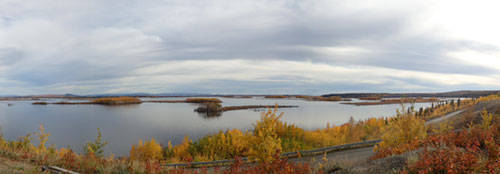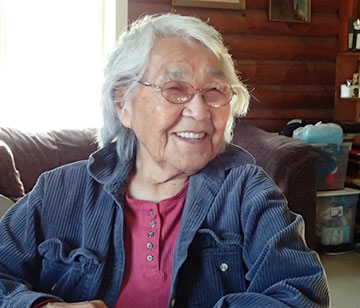
Minto earthquakes then,
|
|||
At her kitchen table in Minto, Alaska, 89-year-old Sarah Silas remembers a 1947 earthquake. |
"My three-year old boy was laughing," she said inside her log cabin, its front door open to warm air on a golden day. "The ground was moving so much I couldn't even reach my little son."
Silas, with her husband Bergman a gracious host to a visiting seismologist, was one of a few people in this village of about 200 who remembered an earthquake in October 1947. The earthquake scientist, Carl Tape, was in Minto to interview elders and check on the installation of a super-sensitive instrument that detects ground motion.
A few blocks away at the Minto airport, two contractors were drilling a nine-foot hole that would soon be the home to a seismometer. That sophisticated earthquake detector is part of a plan to carpet Alaska with like instruments about every 50 miles, from the Alaska Peninsula to Barrow.
The EarthScope Project is a traveling band of seismometers that has blanketed the continental states in past years. This summer, technicians and scientists have installed 20 stations in Alaska, including the one in Minto. Next year, workers with the National Science Foundation-funded project will try to install 40 more seismometers in some of the loneliest spots in Alaska and the Yukon. If that goes well, 80 more installations will follow in 2016.
With Alaska peppered with the stations, which will record earthquakes for a few years before most are removed and used elsewhere, seismologists hope to find out more about weak spots in Earth's crust that slip to cause earthquakes. One of the more intriguing areas is the chain-of-lakes country outside the window of the Silases’ cabin.

The view of Minto Flats from the town of Minto.
Photo by Ned Rozell.
Tape, a researcher at the University of Alaska Fairbanks's Geophysical Institute, describes the Minto Flats seismic zone as a bowl of jellied soil the size of Mt. Everest. He is quite happy for the new seismometer at the Minto airport. It will help him and other scientists understand more about faults beneath the swampy, self-healing surface. When the ground slips there, it produces earthquakes like the magnitude 5.0 that happened 10 miles east of Minto on Aug. 30, 2014.
"In the past, you've had earthquakes in this region 1,000 times larger than two weeks ago," Tape told 25 students in the Minto school before he walked over to knock on the door of Bergman and Sarah Silas. Almost every kid in the class had a story about the recent earthquake. One girl said her parents thought a tree had fallen on their one-story cabin.
At the Silas home, Tape was recording Bergman and Sarah's stories of the 1947 earthquake, a magnitude 7.2. The Silases, married 70 years, both remembered intense shaking where they lived then on the Tanana River, at a site about 25 miles away known as Old Minto. Villagers moved from Old Minto to here above the Tolovana River flats in 1969. With the relocation, Bergman Silas said, they entered a world with electricity, TVs and telephones.
"Before, we just lived by telling stories," Bergman said.
Now, the village of Minto has a scientific device that hears the Earth from beneath airport gravel. The instrument will record the passage of four wheelers, the tire bumps of the mail plane from Fairbanks and tremors in the ground from the restless lake country to the east. Seconds after earthquakes happen, scientists in Fairbanks and around the world will be able to see them for the first time with such exquisite detail.
Since the late 1970s, the director of the Geophysical Institute at the University of Alaska Fairbanks has supported the writing and free distribution of this column to news media outlets. 2014 is Ned Rozell's 20th year as a science writer for the Geophysical Institute.
Email Ned Rozell at nrozell@gi.alaska.edu
SitNews ©2014
Stories In The News
Ketchikan, Alaska
Articles & photographs that appear in SitNews may be protected by copyright and may not be reprinted without written permission from and payment of any required fees to the proper sources.
E-mail your news & photos to editor@sitnews.us
Photographers choosing to submit photographs for publication to SitNews are in doing so granting their permission for publication and for archiving. SitNews does not sell photographs. All requests for purchasing a photograph will be emailed to the photographer.
